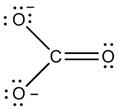
Interpretation:
The formula for ionic compounds formed by ions from group 2 and polyatomic ions composed of carbon and oxygen..
Concept introduction:
Chemical compounds are formed when the atoms, ions or molecules of two substances are attracted towards each other forming a
Answer to Problem 27PP
The formula of ionic compound formed by ions from group 2 and polyatomic ions composed of carbon and oxygen is
Explanation of Solution
The periodic table depicts the position of group 2 elements.

The group 2 elements are also said to be alkaline earth metals. It has electronic configuration of
The polyatomic ion composed of carbon and oxygen carbon atom is carbon bonded to 3 oxygen atoms. Here carbon atom forms 1 double bond with one oxygen atom and two single bonds with two oxygen. Has overall charge of -2.

The polyatomic ion is
The alkaline earth metal ion has +2 charge and carbonate ion has -2 charge. The ionic compound formed by combination of group 2, assumed to be ‘A’ and carbonate ion is
The formula of ionic compound composedformed by ions from group 2 and polyatomic ions composed of carbon and oxygen is
Chapter 7 Solutions
Chemistry: Matter and Change
Additional Science Textbook Solutions
Organic Chemistry (8th Edition)
Chemistry: The Central Science (14th Edition)
General, Organic, and Biological Chemistry (3rd Edition)
CHEMISTRY-TEXT
Introductory Chemistry (5th Edition) (Standalone Book)
Chemistry: Structure and Properties
 ChemistryChemistryISBN:9781305957404Author:Steven S. Zumdahl, Susan A. Zumdahl, Donald J. DeCostePublisher:Cengage Learning
ChemistryChemistryISBN:9781305957404Author:Steven S. Zumdahl, Susan A. Zumdahl, Donald J. DeCostePublisher:Cengage Learning ChemistryChemistryISBN:9781259911156Author:Raymond Chang Dr., Jason Overby ProfessorPublisher:McGraw-Hill Education
ChemistryChemistryISBN:9781259911156Author:Raymond Chang Dr., Jason Overby ProfessorPublisher:McGraw-Hill Education Principles of Instrumental AnalysisChemistryISBN:9781305577213Author:Douglas A. Skoog, F. James Holler, Stanley R. CrouchPublisher:Cengage Learning
Principles of Instrumental AnalysisChemistryISBN:9781305577213Author:Douglas A. Skoog, F. James Holler, Stanley R. CrouchPublisher:Cengage Learning Organic ChemistryChemistryISBN:9780078021558Author:Janice Gorzynski Smith Dr.Publisher:McGraw-Hill Education
Organic ChemistryChemistryISBN:9780078021558Author:Janice Gorzynski Smith Dr.Publisher:McGraw-Hill Education Chemistry: Principles and ReactionsChemistryISBN:9781305079373Author:William L. Masterton, Cecile N. HurleyPublisher:Cengage Learning
Chemistry: Principles and ReactionsChemistryISBN:9781305079373Author:William L. Masterton, Cecile N. HurleyPublisher:Cengage Learning Elementary Principles of Chemical Processes, Bind...ChemistryISBN:9781118431221Author:Richard M. Felder, Ronald W. Rousseau, Lisa G. BullardPublisher:WILEY
Elementary Principles of Chemical Processes, Bind...ChemistryISBN:9781118431221Author:Richard M. Felder, Ronald W. Rousseau, Lisa G. BullardPublisher:WILEY





